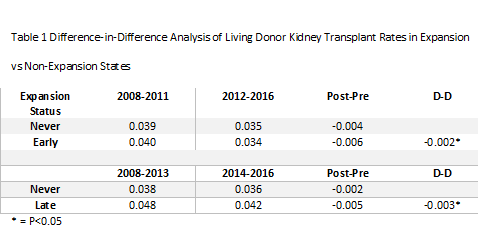Variation in Living Donor Kidney Transplantation and the Impact of Medicaid Expansion
1Department of Surgery, Emory University, Atlanta, GA, 2SOM: Medicine: Nephrology, Emory University, Atlanta, GA
Meeting: 2019 American Transplant Congress
Abstract number: B274
Keywords: Donation, Kidney, Kidney transplantation, Public policy
Session Information
Session Name: Poster Session B: Kidney Living Donor: Quality and Selection
Session Type: Poster Session
Date: Sunday, June 2, 2019
Session Time: 6:00pm-7:00pm
 Presentation Time: 6:00pm-7:00pm
Presentation Time: 6:00pm-7:00pm
Location: Hall C & D
*Purpose: Living donor kidney transplant (LDKTx) is the preferred treatment for end-stage renal disease (ESRD). Medicaid Expansion increased insurance coverage and this influx of insured patients may impact kidney transplantation. In this study we describe variation in LDKTx rates and estimate the impact that Medicaid expansion had on patients’ likelihood of receiving a LDKTx.
*Methods: Using United Network for Organ Sharing (UNOS) and United States Renal Data System data we describe variation in LDKTx and examine factors associated with rates of LDKTx among waitlisted patients in 2016. We graphed LDKTx rates at the transplant center-level and the UNOS regional-level. We examined transplant center factors that may drive differences in LDKTx using ordinary least squares. We use both difference-in-difference and ordinary least squares analyses to examine the impact of Medicaid Expansion on LDKTx rates.
*Results: The distribution of LDKTx rates suggests that while most centers performed relatively low rates of LDKTxs, some centers vastly outperform others (Range: 0-19.3% of waitlisted patients in 2016). The percentage of patients waitlisted at a center that were black was negatively associated with the number of LDKTxs at that center(p<0.001). LDKTx rates in Early states declined ~ 0.2 percentage points after expansion, while Late states declined ~0.3 percentage points (both relative to Never expansion states)
. When we examine the likelihood of receiving a LDKTx at the patient level we find that expansion is associated with a decrease in the likelihood of LDKTx within the first year of 2.3 percentage points (p<0.001).
*Conclusions: There exists considerable variation in LDKTx rates at the transplant center and regional levels, suggesting that initiatives to encourage living donation may be beneficial. After Medicaid Expansion, rates of LDKTx decreased. Medicaid expansion increased insurance coverage, but did not improve access to LDKTx, meaning that insurance is perhaps necessary, but not sufficient, to provide access to optimal treatment. The significant variation seen across transplant centers is concerning as we work towards equitable treatment for patients across the nation.
To cite this abstract in AMA style:
Melanson TA, Pastan S, Patzer R. Variation in Living Donor Kidney Transplantation and the Impact of Medicaid Expansion [abstract]. Am J Transplant. 2019; 19 (suppl 3). https://atcmeetingabstracts.com/abstract/variation-in-living-donor-kidney-transplantation-and-the-impact-of-medicaid-expansion/. Accessed December 21, 2025.« Back to 2019 American Transplant Congress


